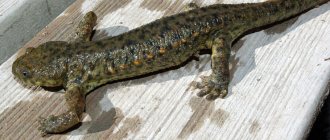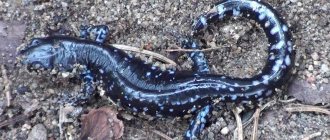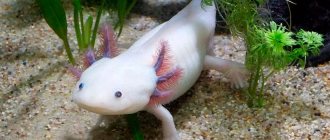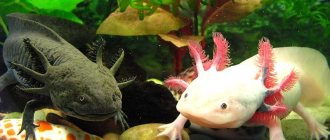The water agama is a lizard common in China, Thailand, Malaysia and other countries in Southeast Asia. Biologists call it Physignathus cocincinus. This is a fairly large species; males can reach a length of one and a half meters including the tail. If the right living conditions are created and the terrarium is kept clean, the life expectancy of an agama can be 20 years.
Lizards usually choose warm places near bodies of water. They can often be found on the banks of rivers and lakes, where they bask in the sun. Reptiles often climb onto branches and are especially active during the day. Agamas are good swimmers and can even run on water - at the first sign of danger, they can jump into a pond and quickly run away from their pursuer. An interesting fact is that these divers can spend up to 25 minutes underwater.
Rules for keeping a water agama
The water agama is well suited for keeping at home. The reptile has a friendly disposition, makes good contact with humans, and quickly gets used to the owner.
Some individuals may be naturally timid and may not be easily handled. It is important not to show rudeness or aggression when meeting them for the first time. The animal does not like to be grabbed sharply or make loud noises. Therefore, you should be especially careful in the first days of keeping it so that the lizard does not begin to see you as a threat.
It doesn't take much time to tame. The main thing that the reptile needs is to get used to your smell and understand that you do not pose a danger and are determined to make friends with it.
Lifestyle and habitat
Sea dogs are phlegmatic. They lead a measured, calm lifestyle and prefer a wait-and-see strategy when hunting - the best option is when the food itself floats to the axolotl.
Revival occurs during the breeding season.
Axolotls are listed in the Red Book as an endangered species. Their natural habitat was lakes Xochimilco and Cholco in Mexico , but with the onset of urban development, the natural range of water dogs declined sharply.
Terrarium for agama
To keep a water agama, you need a terrarium of a suitable size, soil and decor, and special conditions in terms of humidity and temperature.
The terrarium for an adult must be at least 45x45x90 cm for a female and 60x45x90 cm for a male. A terrarium with parameters of 90×45×90 cm would be optimal for one individual or a couple. Since agamas love to climb branches, you need to provide them with this opportunity.
Description
Confusion often arises: the axolotl is called an ambistoma and an ambisto axolotl - this is not entirely true. Axolotl and Ambystoma are two phases (juvenile and adult) of one animal.
Thus, it is customary to call axolotls the larvae of the Mexican and tiger ambystoma, so the grown axolotl is an ambystoma .
In this case, the water dog can reach sexual maturity and reproduce without growing out of the juvenile phase - this property is called neoteny.
The “culprit” of such an amazing metamorphosis is a hereditary deficiency of the hormone thyroidin .
The water monster most resembles a cute, happy dragon. Strengthening this resemblance are three pairs of vertically set external gills protruding behind the axolotl's head .
Ambystoma larvae are predators and have a set of impressive (proportional to their size) sharp teeth with which they hold prey.
Body length usually does not exceed 35 cm, with females noticeably smaller than males. A large, well-developed tail helps the axolotl maneuver and move underwater.
Two pairs of paws on the sides of the body end in long, well-developed fingers, with which the water dog clings to the ground and stones.
Under natural conditions, the amphibian’s color is dark, but in a home aquarium, black and albino axolotls live .
A small educational program:
- What kind of heart and circulatory system does the larva have? Like an amphibian: a three-chambered heart and two circles of blood circulation.
- How long does an axolotl live? In an aquarium, the larva can live 15–20 years with proper care and feeding.
Heating and light
Without proper heating of the terrarium, it will not be possible to keep a reptile at home. Here are a few rules for installing lamps and heating:
- Bottom heating is not suitable for this type. In nature, the lizard sits on a branch most of the time and receives heat from the sun's rays.
- Warm and cold areas should be created in the terrarium. The maximum temperature reaches 35, and the minimum - 22 degrees.
- The lamp must be placed outside the terrarium so that the animal does not get burned.
- The terrarium must be equipped with an ultraviolet lamp. It will promote the absorption of nutrients, the production of vitamin D3, the risk of disease will decrease, and the pet will look healthier.
Diseases and their prevention
Important! Do not pick up the axolotl! This may cause burns to appear on its body as the human body temperature is too high for a water dog.
If there is a need to remove a larva from a reservoir, for example, to quarantine it or provide first aid, it is better to use a soft cloth net or pre-cool your hands with ice .
In most cases, illnesses in Ambystoma larvae are a consequence of disturbed living conditions.
The most common problems:
- Intestinal obstruction . It occurs due to the fact that the axolotl swallows particles of soil while feeding. Symptoms: lethargy and complete refusal to eat. Unfortunately, only surgery can help in this case.
- Lesions of cartilage tissue . This is a consequence of a violation of the vitamin-mineral balance. Most likely, the axolotl does not have enough calcium and vitamin D, but changing the diet on your own is unacceptable; it is better to consult a veterinarian. Signs of deficiency development will be apathy and lethargy.
- Ambystoma larva suffers from anorexia . Symptoms include refusal to eat and a bloated body. Therapy is prescribed by a veterinarian.
- It is not uncommon for an axolotl to develop ascites . The cause of the disease is poor quality food and excessive pollution of the reservoir. Therapy is prescribed by a veterinarian.
Water and humidity
Since water agamas live near bodies of water, it is necessary to create a humidity of at least 60%. Some individuals will be more comfortable at 80% humidity.
To create the necessary conditions, you will need a few simple steps:
- In the morning and evening, spray the inside of the terrarium with a spray bottle.
- Install a fogger, it will maintain humidity up to 100%.
- You can install a filter in the pond to make cleaning up after your pet easier. Water changes occur every few months.
Keeping at home
Keeping a water dog at home is not easy: the activity will require certain skills and the creation of suitable conditions.
But with proper care and a properly organized diet, an axolotl can live next to its owner for many years .
Aquarium preparation
To successfully maintain Ambystoma larvae, it is necessary to create suitable conditions.
So, the optimal volume for keeping one water dog should not be less than 40 liters , but exceeding this limit is not at all prohibited. Accordingly, for a pair of axolotls you will need a tank 2 times larger.
Only clean, chlorine-free and well-settled water is suitable for an aquarium.
A filter must be chosen that is powerful, but does not create a strong current and without an open hole for water intake, in order to prevent injury to the gills of the larvae.
The temperature of the reservoir should not rise above 21 °C. The optimal temperature range is from 15 to 20 °C , which creates certain difficulties in the summer heat.
Important! For the bottom substrate you need to choose large stones. The small fraction of pebbles and sand are not suitable for decorating the bottom, since water dogs can swallow their elements, which will lead to intestinal obstruction.
Shelters must be arranged at the bottom where a water dog can hide:
- driftwood;
- grottoes;
- artificial caves.
Water preparation
This is an important stage in creating comfortable conditions for the water dog. Parameters of the aquatic environment:
- temperature 15...21 °C;
- medium hardness;
- acidity is medium;
- good aeration;
- weekly water changes of about 20% of the tank volume;
- water should not contain impurities (especially chlorine).
View this post on Instagram
Publication from Oleg Mikhailov (@olegi4.insta) Jun 28, 2021 at 2:47 PDT
To keep a water dog, it is not at all necessary to install additional lighting on the aquarium : on the contrary, the Ambystoma larva prefers shaded reservoirs. It is better to place the tank away from direct sunlight.
What to feed
Axolotl is a predator. His diet should contain protein foods of animal origin (pieces of lean fish, shrimp meat, chopped worms). Food for predatory fish in the form of granules or tablets is also suitable.
The basic feeding rules are identical to the recommendations for the diet of fish:
- avoid overeating;
- Do not leave leftover food in the aquarium;
- Do not use mammalian meat as feed.
Food should be given as much as the axolotl can eat at one time to avoid water contamination. The Ambystoma larva is fed once every 2–3 days .
Attention! The water dog is prone to overeating and will eat as much as you give. In fact, an axolotl can go without food for 2 weeks without much harm to its health.
Sharing with fish
A water dog should not be kept in the same aquarium with fish . The predator will hunt the small ones itself, and the large ones will annoy the axolotl (there are known cases when large unfriendly neighbors ate the gills of an Ambystoma larva).
In addition, often the temperature conditions of the fish and the water dog do not coincide: the axolotl is a cold-water animal, while fish prefer warmer bodies of water.
Feeding
During the active growth stage, agamas love to eat. Feeding is carried out every day. Reptiles should receive balanced food high in protein: insects and small rodents. Among the favorite delicacies of agamas are crickets and locusts.
When your pet reaches maturity, you can switch from the daily feeding regimen to a different schedule - about three times a week. Here you will have to take care of providing larger food - mice or adult locusts. Agamas are excellent feeders when defrosted.
Don’t forget about the need to add natural vitamins to your diet. They are found in greens and vegetables. It’s good if your agama’s diet includes carrots and zucchini. Although here the situation is individual. Each individual has its own taste preferences - some enjoy eating salad, others can’t tear themselves away from strawberries. They do not eat plant foods as often as protein foods.
Types of axolotl
There are several types of water dogs. Some can be kept in a home aquarium, while some larvae are found only in natural bodies of water.
Aquarium axolotls
Several varieties are suitable for home keeping:
- golden axolotl;
- axolotl furry;
- Mexican;
- white;
- albino;
- harlequin.
Tiger Ambystoma (Axolotl)
Or North American Ambystoma. Its axolotls vary greatly in size and skin color. Geographically, Ambystoma and its larvae are distributed from the northern regions of Mexico to Canada.
The adult has a variable color: it can be brown, greenish-brown or olive with yellow or ocher spots. The average body length is about 28 cm, but there are individuals over 35 cm.
Marbled Ambystoma (Axolotls)
They are similar to tiger ambystoms. They differ in color: it is darker, almost black, with light gray spots (which became the basis for the name).
The body size is modest - about 12 cm. They live in the United States from Florida to the Great Lakes region.
Mole-shaped Ambystoma
These axolotls develop into adult form, as they prefer to choose moist soils rather than bodies of water for breeding.
The carcass size is small, 8–9 cm, color is earthy brown with a spotted pattern. The areas of South Atlanta where this species lives have a humid climate and create optimal conditions for their life.
Pacific Ambystoma
The axolotl of this species is an intermediate form, since the ambistoma reproduces on land (it lays eggs in the sand).
It is distinguished by its large dimensions (individuals over 40 cm are found). Geographically distributed on the coasts of British Columbia and California.
Olympic ambistomes
Small ambistomas (about 12 cm). The axolotl is an intermediate form, since reproduction occurs on land (in the riparian areas of mountain streams in the western regions of the United States).
Mexican Ambystoma
It is this species that exhibits neoteny and is often called the “axolotl salamander.” Based on the larvae of the Mexican Ambystoma, several artificially bred varieties have been obtained that can live in aquariums.
Choosing soil
Another important detail that is sometimes underestimated is the substrate. Most often, aquarists choose the color, shape and size of the soil at their own discretion. But for the Mexican lizard this factor is very important. For example, in an aquarium without soil, an axolotl feels very uncomfortable. This causes unnecessary stress and can even cause sores on the tips of the paws.
Gravel is also not very suitable for the axolotl, since it is quite often swallowed by it. This leads to blockage of the gastrointestinal tract and death of the animal. It is believed that the ideal option for keeping this lizard is sand. He allows her to crawl freely along the bottom.
Aquarium decoration
This is largely a matter of the owner's taste, although some rules should be followed. Small (young) individuals can be kept in small containers (50 liters). Adult lizards require a larger volume (100 liters for one or two individuals). If you want to keep a larger number, then the volume of the aquarium should be 50-80 liters for each axolotl.
The decor of the aquarium should not have sharp burrs and edges - they can injure the delicate skin of your pet. Also, take care of shelters. There should be more of them than the number of individuals kept.
Compatibility
Experienced aquarists know how important this factor is. However, most often owners keep axolotls separately, and there are a number of reasons for this. The external gills of these lizards make them easily vulnerable to attack by fish. Even the calmest and slowest aquarium fish are unlikely to resist the urge to bite them. As a result, luxurious shoots turn into pitiful scraps.
In addition, the axolotl is active at night, making sleeping fish easy prey. It is quite difficult to find a middle ground between size (so that the fish does not get eaten) and aggressiveness (so that the axolotl does not get offended).
But there is an exception that allows lizards to be kept with fish. These are goldfish. They are so slow that when fed well, they do not even try to injure the axolotl. In addition, goldfish also require low water temperatures.
Axolotl: maintenance and care
Keeping such an exotic pet at home is not difficult, but there are aspects that affect their life expectancy. The first (and most important) is water temperature. Axolotls are cold-blooded amphibians, so elevated temperatures are a great stress for them. At first glance, it may seem strange that these lizards come from Mexico and cannot tolerate high temperatures. This is explained quite simply. The fact is that their habitat is located at high altitudes, where the temperature is much lower than in the rest of the country.
Axolotl: maintenance and care, description, feeding
This fantastic animal is the dream of every aquarist.
The axolotl, which is easy to keep and care for, is a neotenic salamander larva. Axolotl dragons (as these lizards are often called) are gradually disappearing from the wild as a result of rapid urbanization. True, they reproduce quite successfully in captivity, which allows them to maintain their numbers. The axolotl lizard is of scientific value due to its amazing ability to regenerate its tail, gills and even limbs. Currently, there are quite a lot of them kept in home aquariums.









